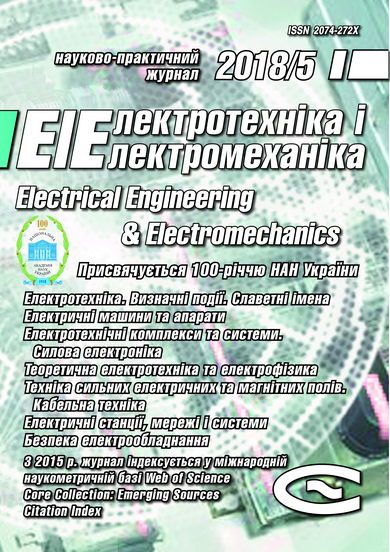INVESTIGATION OF LINEAR PULSE ELECTROMECHANICAL CONVERTER OF INDUCTION TYPE WITH DOUBLE ARMATURE INTENDED FOR DESTROYING INFORMATION ON SSD STORAGE DEVICE
DOI:
https://doi.org/10.20998/2074-272X.2018.5.03Keywords:
linear pulse electromechanical converter of induction type, double armature, electrodynamic processes, digital SSD storage device, experimental sampleAbstract
Purpose. The goal of the paper is to determine the influence of the linear pulse electromechanical converter (LPEC) parameters with a double armature on its electrical, power and temperature indices and experimental verification of the proposed design for an information destruction device in a flat SSD storage device. Methodology. Using the mathematical model that takes into account interrelated electrical, magnetic, thermal and mechanical processes, the influence of geometric parameters on the electrodynamic characteristics and the indices of the induction type LPEC with a double armature spanning the inductor from opposite sides is investigated. Results. It is shown that the currents in the inductor and armature change in accordance with the oscillation-damping law practically in antiphase. The maximum value of the current density in the inductor is 215.8 A/mm2, and in each of the identical parts of the double armature it is 299.7 A/mm2. The maximum value of electrodynamic forces (EDF) acting in opposite directions on the front and rear of the double armature is 11.99 kN, and the value of the EDF pulse is 4.59 N∙s. Originality. It is established that with axial removal of the rear part of the armature from the inductor, the maximum current densities in the inductor decrease, in the front part of the armature increase, and in the rear part of the armature decrease. The maximum value and the pulse of the EDF between the armature parts decrease. With an increase in the number of turns in the inductor and a decrease in the thickness of the copper bus, all the basic indicators of the LPEC increase. With an increase in the number of turns of the inductor from 26 to 56, the maximum EDF value acting between the parts of the armature increases almost 3 times, and the magnitude of the EDF pulse is 3.3 times. With an increase in the width of the copper bus and the width of the inductor, the main indicators of the LPEC decrease. With an increase in the width of the inductor from 10 mm to 20 mm, the maximum EDF between the armature parts decreases by 1.3 times, and the value of the EDF pulse decreases by 1.2 times. Practical value. Based on the conducted studies, an induction-type LPEC model with a double armature was designed and tested experimentally, designed to destroy information located on a solid-state digital SSD storage device.References
1. Tomashevsky D.N., Koshkin A.N. Modeling of linear impulse electric motors. Russian Electrical Engineering, 2006, no.1, pp. 24-27. (Rus).
2. Ivashin V.V., Penchev V.P. Features of the dynamics of work and energy diagrams of pulsed electromagnetic drive with parallel and series connection of excitation windings. Electrical engineering, 2013, no.6, pp. 42-46. (Rus).
3. Bolyukh V.F., Luchuk V.F., Rassokha M.A., Shchukin I.S. High-efficiency impact electromechanical converter. Russian electrical engineering, 2011, vol.82, no.2, pp. 104-110. doi: 10.3103/s1068371211020027.
4. Bolyukh V.F., Shchukin I.S. Lineinye induktsionno-dinamicheskie preobrazovateli [Linear induction-dynamic converters].Saarbrucken,Germany, LAP Lambert Academic Publ., 2014. 496 p. (Rus).
5. Ivanov V.V., Paranin S.N., Nozdrin A.A. Semiautomatic installation of magnetic pulse compaction of powders. Materialovedenie, 2011, no.7, pp. 42-45. (Rus).
6. Young-woo Jeong, Seok-won Lee, Young-geun Kim, Hyun-wook Lee. High-speed AC circuit breaker and high-speed OCD. 22nd International Conference and Exhibition on Electricity Distribution (CIRED 2013), 2013, 10-13 June, Stockholm, Paper 608. doi: 10.1049/cp.2013.0834.
7. Bolyukh V.F., Shchukin I.S. High-performance electromechanical and electromagnetic pulse devices for destruction of information on digital drives. Electrical engineering and electromechanics, 2015, no.5, pp. 36-46. (Rus). doi: 10.20998/2074-272x.2015.5.05.
8. Bolyukh V.F., Luchuk V.F., Shchukin I.S. Ustroistvo unichtozheniia informatsii, razmeshchennoi na tverdotel'nom tsifrovom SSD nakopitele [A device for destroying information located on a solid state digital SSD drive]. PatentRussian Federation, no. 2654163, 2018. (Rus).
9. Bissal A., Magnusson J., Engdahl G. Comparison of two ultra-fast actuator concept. IEEE Transactions on Magnetics, 2012, vol.48, no.11, pp. 3315-3318. doi: 10.1109/tmag.2012.2198447.
10. Schneider Electric Industries SAS. Electric switching device with ultra-fast actuating mechanism and hybrid switch comprising one such device. Patent USA, no.8686814, 2014.
11. Bolyukh V.F., Dan’ko V.G., Oleksenko S.V. The Effect of an External Shield on the Efficiency of an Induction-Type Linear-Pulse Electromechanical Converter. Russian Electrical Engineering, 2018, vol.89, no.4, pp. 275-281. doi: 10.3103/s106837121804003x.
12. Bolyukh V.F., Kocherga A.I., Schukin I.S. Investigation of a linear pulse-induction electromechanical converter with different inductor power supply circuits. Electrical engineering & electromechanics, 2018, no.2, pp. 11-17. (Rus). doi: 10.20998/2074-272X.2018.2.02.
13. Bolyukh V.F., Kocherga A.I., Schukin I.S. Investigation of a linear pulse-induction electromechanical converter with different inductor power supply circuits. Electrical engineering & electromechanics, 2018, no.1, pp. 21-28. (Rus). doi: 10.20998/2074-272X.2018.1.03.
14. Bolyukh V.F., Kocherga A.A., Shchukin I.S. Comparative analysis of constructive types of combined linear pulse electromechanical converters. Technical electrodynamics, 2018, no.4, pp. 84-88. (Ukr). doi: 10.15407/techned2018.04.084.
Downloads
Published
How to Cite
Issue
Section
License
Copyright (c) 2018 V. F. Bolyukh, Yu. V. Kashanskij, A. I. Kocherga, I. S. Schukin

This work is licensed under a Creative Commons Attribution-NonCommercial 4.0 International License.
Authors who publish with this journal agree to the following terms:
1. Authors retain copyright and grant the journal right of first publication with the work simultaneously licensed under a Creative Commons Attribution License that allows others to share the work with an acknowledgement of the work's authorship and initial publication in this journal.
2. Authors are able to enter into separate, additional contractual arrangements for the non-exclusive distribution of the journal's published version of the work (e.g., post it to an institutional repository or publish it in a book), with an acknowledgement of its initial publication in this journal.
3. Authors are permitted and encouraged to post their work online (e.g., in institutional repositories or on their website) prior to and during the submission process, as it can lead to productive exchanges, as well as earlier and greater citation of published work.





